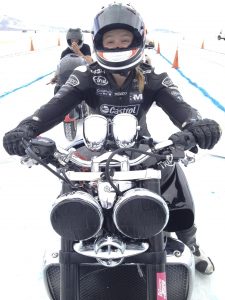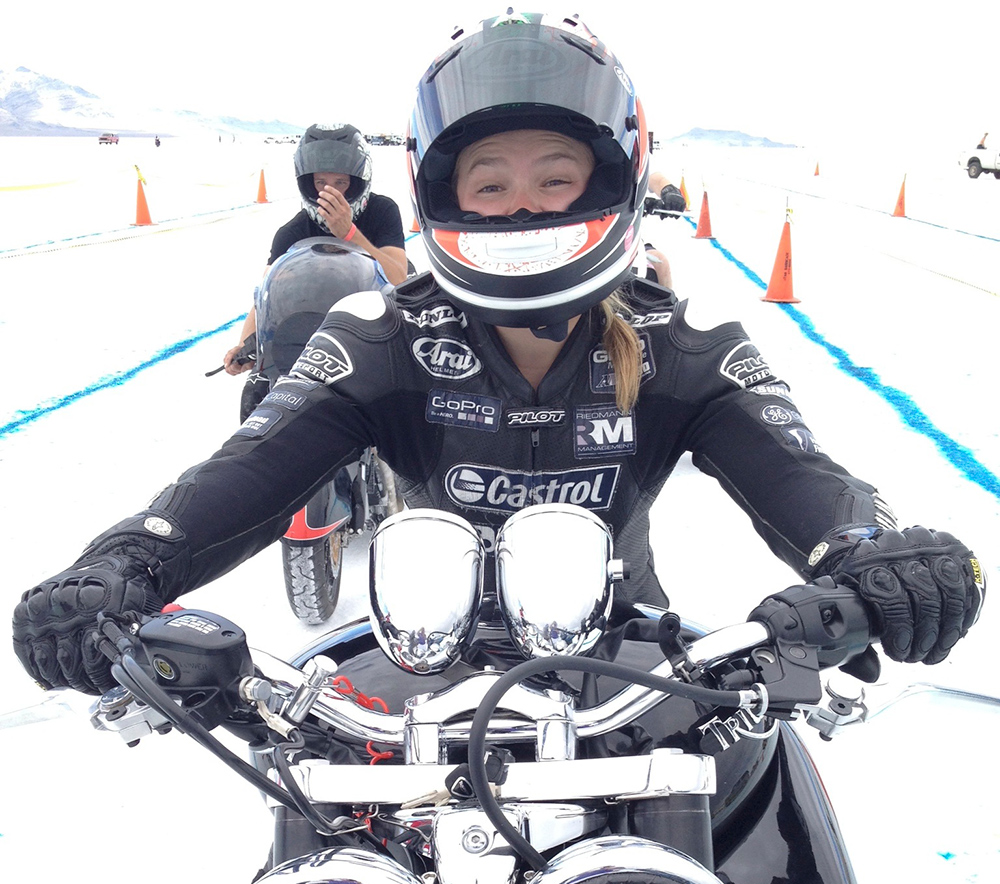 Bonneville Salt Flats: truly a place like no other. Pure white salt stretches out as far as the eye can see. It’s so flat, and so smooth, it’s almost as if you can see the curvature of the earth where the salt meets the horizon. This stunning piece of earth is fascinating to most people, but to speed freaks, including me, it’s heaven on earth.
Bonneville Salt Flats: truly a place like no other. Pure white salt stretches out as far as the eye can see. It’s so flat, and so smooth, it’s almost as if you can see the curvature of the earth where the salt meets the horizon. This stunning piece of earth is fascinating to most people, but to speed freaks, including me, it’s heaven on earth.
The flats spread out over 40 square miles of Tooele County, out in the desert west of Salt Lake City and the Great Salt Lake. For the past 100 years, a small section called the Bonneville Speedway has been one of the best places in the world to break land speed records. There just aren’t a lot of wide open, flat spaces where you can set up a straight track long enough to hit triple-digit speeds. The world land speed record for any wheel driven machine, and the world land speed record for any motorcycle were both set here. How’s that for prestigious?
In August, 2013 I got the chance to try to break a land speed record of my own on-board a Triumph Rocket III. At the time, I was racing for Triumph in the AMA’s premier 600 class, Daytona Sportbike, and they wanted me to be a part of their extravagant return to the salt flats.
This was to be the year Triumph would break the world land speed record on a motorcycle. They had spent two years and a couple million dollars on a two-wheeled land rocket they thought could hit 400 miles per hour. It was top secret, and it was going to be the craziest thing that had ever happened on the salt flats. I would be the side show.
There are dozens and dozens of records you can go after–probably one for every type of bike and all its possible modifications. Triumph chose a couple they thought would be easy pickings for me.
I was excited to get out on the track to see how the surface felt, how the horizon looks as you race across the seamlessly white earth, and, I hoped to clinch a record. I was also a bit intimidated by the 2300cc, 800-pound, 250 horsepower behemoth I would be saddling up on. I was used to my 130 horsepower, 370-pound Daytona 675 so I wasn’t sure what to expect. But, all I had to do was go straight, hold the throttle wide-open and hit 165 mph. How hard could that be?
Scrutineering
I arrived to the Bonneville Salt Flats on “Scrutineering Day,” which is a fancy term for the intensive scrutinizing of one’s motorcycle and riding gear that all prospective riders must go through. I was blown away by what I saw. I’ve driven past the salt flats many times on Interstate 80 on the way to Miller Motorsports Park (now Utah Motorsports Campus) but it wasn’t until I drove to the paddock area that I realized how wild this place really was. It was as if you could see for forever and then it kept going. Everyone looked like ants in the distance, almost as if you were on another planet. From the highway, it was about a five-mile drive on the salt to get to the oasis of motorcycling.
On my way to the paddock, I passed three courses to my right: The ten-miler, the five-miler and the three-miler, each with a timed mile in the middle that captures the time it takes you to get through and determines your average speed–the speed of record. The front section of each track is to build up speed into the timed mile, and the back section is to cool down. That’s what the extra length is for.
Upon arriving at the Triumph team’s parking spot, I was taken aback by all the people around. I knew Triumph’s undercover project was big, but I don’t think anyone else realized its significance until they saw it. The Streamliner was a wingless carbon fiber airplane body on two wheels, powered by two Triumph Rocket 3 engines. A friend compared it to a big black crayon–with 1000 horsepower, it was said.
My teammate in AMA RoadRacing, Jason DiSalvo, was to “pilot” this machine, and I honestly could not have been more terrified for him. It had cut outs just big enough for the wheels to poke through the bottom, and a tiny cockpit that he was barely able to squeeze into. It was an incredible looking machine, but completely unproven. It was all hands on deck for this project so needless to say, my effort was low on the priority list.
Walk in the park
Nonetheless, I was focused on my job: Hit 165 miles per hour. For someone well-accustomed to 180 to 190 miles per hour, that seemed like a walk in the park, especially given the distance to build up to it.
Then I hit the track. And let me tell you, this was the most terrified I’ve ever been on a motorcycle. For the first few runs, I got used to the procedures–only one person can be on the track at a time, and there are people at both ends communicating back and forth as to when to start the next rider–the five-mile course, and the bike and how it reacted on the salt. These runs were in the 140s so there was definitely a long way to go to hit the record. But, it was early on in the week and I had full confidence in being able to get there.
I went into the next day prepared to see what this bike could do. I started each run the same, smoothly rolling on the throttle, making sure my feet were in a good place and getting into the most aerodynamic position possible. Once that was established, I accelerated a bit more until I could feel the bike moving a bit underneath me. For my first few good runs I held that speed until just before the timed mile when I got on the gas a bit more. But, I found that if I got on the gas too hard, the rear would break loose and fish tail. I would have to roll off at that point, and my timed mile would be chalked up as a lesson learned.
Throughout the next day, I tried different combinations of how hard to get on the gas and when, but my biggest struggle was holding onto the bike for more than a mile at speed. On the Rocket III, you’re essentially sitting on this cruiser with no wind protection, super wide gas tank to try and grip onto, and your feet are in front of you.
This is a great position if you’re on a Sunday ride, but this was not an aerodynamic machine. The wind hit me hard in the chest, and I thought it was going to push me off the back of the motorcycle. I could hardly grip the tank with my knees, and my feet were sitting there useless, because you can’t control anything with them up there. So, it was me against the 160 mph wind.
By the time I got to the timed mile, I was pooped. I did all I could leading up to it to hang on and stay as close to full throttle as possible, all the while I was trying to get the back end to stop spinning and the front to stop head shaking. There were many times I thought I was going to get flung off the bike like a rag doll. This beast seemed like it didn’t want me on it, though I’m not sure it even noticed my 125 pounds.
Big flop
Run after run, I tried getting on the gas more and earlier in the course, but I found it difficult to grip the bike while I was in the timed section. A few times I tried getting on the gas more throughout the mile, but I panicked when the front end started shimmying. The handlebars tried ripping themselves out of my hands, and the rear end was fishtailing like I’ve never felt before. This was insane, and I knew we had to do something about it.
After consulting with my crew members, we first tried cutting out a big chunk in the seat to help me sit in the bike more. The idea was to make it so I didn’t have to hold on so tight, but it didn’t do much good. Our next gambit was to push the fork tubes down to create a longer wheelbase and make the bike more stable. That helped a bit. The front end problems subsided but the rear end just didn’t want to seem to hook up. But after those two adjustments, we were pretty much stuck.
We talked with some salt flat veterans about what they might try if they were in the same situation and they all said that my rear tire needed to be changed. I discovered in our conversations with these people that the best tires for the salt are the ones with the smallest contact patch possible. The bike I was riding had a car tire on it, which has a relatively large contact patch, and in all the hoopla about the Streamliner, no one had thought to provide any different tires for me, and even if they had, we didn’t have the tools to mount one. So, even though we understood the problem, there wasn’t anything we could do about it.
I tried to make the best of a bad situation, giving it all I had, all while scaring myself half to death and baking my skin on top of it. It was a hard schedule, especially for anyone who didn’t have the support I had. You only get four runs over the course of the day, if you’re lucky. In the meantime, you wait in line. Everyone gets moved from stage to stage and tries to not overheat.
Luckily for me, my team had a rental car that followed me to each stage so I could get in and chill out in the A/C. There were times where it was an hour before we moved to the next stage. Even though I brought the darkest sunnies I could get hold of, and a bucket load of sunscreen, I still wound up getting burnt under my chin and on the backs of my arms and calves from the reflected light coming off the salt.
I did manage to get a couple good runs in that were within a couple miles per hour of the record. Whenever this happens, race control will send you down to the other end of the course where you wait to do a run back the other direction. This ensures that the records are accurate year after year, and that tailwinds don’t factor into it. Unfortunately, my timed mile back wasn’t good enough to secure any records. I did manage to hit 163, and that was with the throttle only open three quarters of the way. Any further than that, and the bike would have spun out, or I would have been blown off. It was a powerful bike, but there’s no point in having all that power if you can’t control it. After the week we had, I felt like 163 wasn’t too bad.
Bigger flop
Meanwhile, on the other side of camp, things were going even worse. They couldn’t get the Streamliner to run properly, and when they finally got it running, it topped out at 150 mph. Then, it caught fire. Luckily nobody was injured and the fire was extinguished quickly, but they definitely had to go back to the drawing board.
Not so amusing
I like to compare my week at the salt flats to a day at an amusement park. You get a minute of fun, thrills and excitement, and then you get to wait in line for a long time and do it all over again. However in this case, the fun was more like terror, and the wait in line is hours long in the unbearable heat of summer in the dazzling white salt desert.
Although my experience on the bike wasn’t anywhere near as fun as I thought it would be, I still have a lot of great memories from the event, and loads of respect for the folks who do this year in and year out. Between staying at a super divey casino hotel with my crew, eating a fly from a Mexican restaurant chip bowl on a dare for $40, meeting all the cool and crazy folks and seeing some of the contraptions people build in the quest for record breaking speed, I’d say the trip was well worth it. Maybe I’ll get to go back one day better equipped and give it another go.

